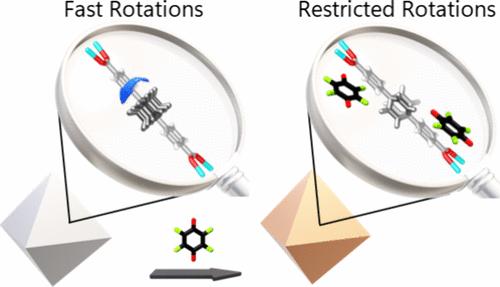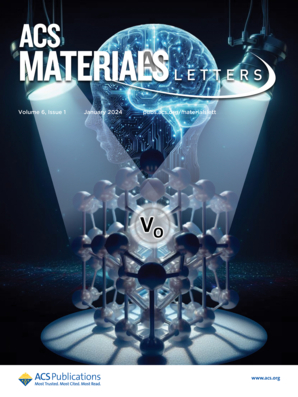通过加入含氟客体调节 Zr 金属有机框架的光物理和内部动力学
IF 8.7
1区 化学
Q1 MATERIALS SCIENCE, MULTIDISCIPLINARY
引用次数: 0
摘要
在此,我们报告了通过吸附 1,4-四氟苯醌(TFBQ)或六氟苯(F6Bz)对 MOF UiO-68 中快速旋转动力学的精确调节。在 TFBQ 的情况下,材料孔隙内同时产生 CT 复合物。氘固态核磁共振和计算模拟证明,有机连接体的中心苯环与含氟分子之间的强π-π堆叠作用大大降低了旋转频率(室温下从数百兆赫降至几兆赫),这与客体浓度有关。此外,TFBQ 与分子转子之间的 CT 相互作用改变了结晶 MOF 的光物理特性,这一点已通过电子自旋共振、紫外-可见光和 PL 测量得到证实。这项研究为开发刺激响应型先进材料迈出了一步,这种材料不仅能改变内部迁移率,还能调节其光物理性质。本文章由计算机程序翻译,如有差异,请以英文原文为准。

Modulation of the Photophysics and Internal Dynamics in a Zr Metal Organic Framework by the Inclusion of Fluorinated Guests
Herein, we report the precise modulation of the fast rotational dynamics in the MOF UiO-68 by the adsorption of 1,4-tetrafluorobenzoquinone (TFBQ) or hexafluorobenzene (F6Bz). In the case of TFBQ, the infiltration was accompanied by the simultaneous generation of CT complexes inside the material’s pores. As evidenced by deuterium solid-state NMR and computational simulations, the strong π–π stacking between the central phenylene rings of the organic linkers with the fluorinated molecules significantly reduced the rotational frequency (from hundreds to a few of MHz at room temperature) according to guest concentration. Furthermore, the CT interaction between TFBQ and the molecular rotors changed the photophysical properties of the crystalline MOF, as confirmed by electron-spin resonance, UV–vis, and PL measurements. This work constitutes a step forward in the development of stimuli-responsive advanced materials that exhibit a change in the internal mobility as well as the modulation of their photophysics.
求助全文
通过发布文献求助,成功后即可免费获取论文全文。
去求助
来源期刊

ACS Materials Letters
MATERIALS SCIENCE, MULTIDISCIPLINARY-
CiteScore
14.60
自引率
3.50%
发文量
261
期刊介绍:
ACS Materials Letters is a journal that publishes high-quality and urgent papers at the forefront of fundamental and applied research in the field of materials science. It aims to bridge the gap between materials and other disciplines such as chemistry, engineering, and biology. The journal encourages multidisciplinary and innovative research that addresses global challenges. Papers submitted to ACS Materials Letters should clearly demonstrate the need for rapid disclosure of key results. The journal is interested in various areas including the design, synthesis, characterization, and evaluation of emerging materials, understanding the relationships between structure, property, and performance, as well as developing materials for applications in energy, environment, biomedical, electronics, and catalysis. The journal has a 2-year impact factor of 11.4 and is dedicated to publishing transformative materials research with fast processing times. The editors and staff of ACS Materials Letters actively participate in major scientific conferences and engage closely with readers and authors. The journal also maintains an active presence on social media to provide authors with greater visibility.
 求助内容:
求助内容: 应助结果提醒方式:
应助结果提醒方式:


